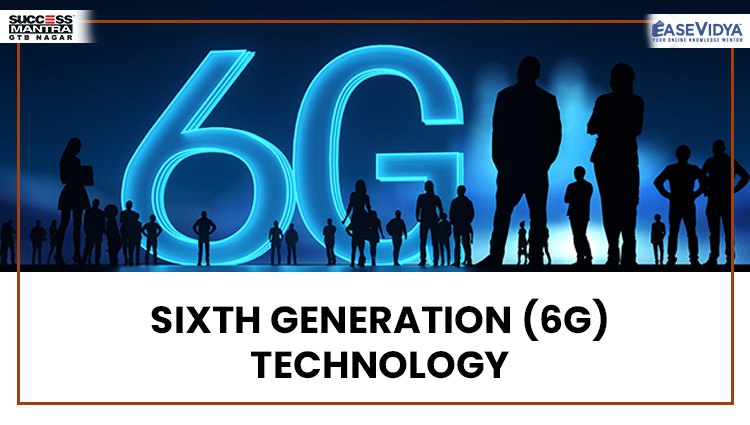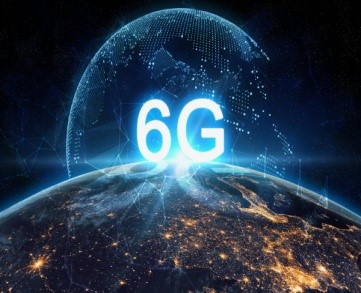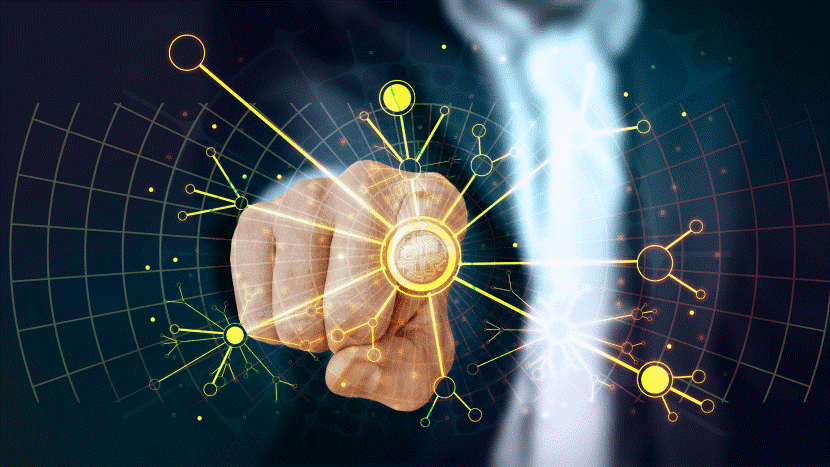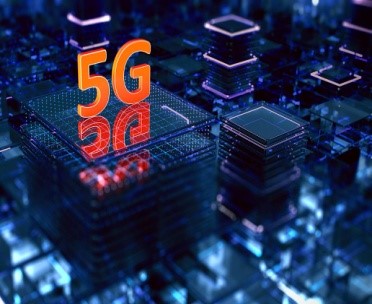
SIXTH GENERATION 6G TECHNOLOGY
SIXTH GENERATION (6G) TECHNOLOGY
Recently, the government has asked the Centre for Development of Telematics (C-DOT) to begin developing 6G and other futuristic technologies to catch up with the global market in time. The next generation telecom technology (6G) is said to be 50 times faster than 5G and is expected to be commercially launched between 2028-2030.

Current Affairs Notes By Success Mantra Coaching Institute GTB Nagar Delhi CLICK HERE
ABOUT 6G TECHNOLOGY
6G (sixth-generation wireless) is the successor to 5G cellular technology. It will be able to use higher frequencies than 5G networks and provide substantially higher capacity and much lower latency (delay). One of the goals of 6G internet will be to support one microsecond-latency communication (delay of one-microsecond in communication). This is 1,000 times faster - or 1/1000th the latency - than one millisecond throughput. It seeks to utilize the terahertz band of frequency which is currently unutilized. Terahertz waves fall between infrared waves and microwaves on the electromagnetic spectrum. These waves are extremely tiny and fragile, but there's a huge amount of free spectrum up there that would allow for spectacular data rates.
SIGNIFICANCE OF THE TECHNOLOGY
- More facilitation: The 6G technology market is expected to facilitate large improvements in imaging, presence technology and location awareness. 6G's higher frequencies will enable much faster sampling rates, in addition to providing significantly better throughput and higher data rates.
- Advancement in Wireless sensing technology: The combination of sub-mm waves (e.g., wavelengths smaller than one millimeter) and frequency selectivity to determine relative electromagnetic absorption rates could potentially lead to significant advances in wireless sensing technology.
- Emergence of Digital Capabilities: It will see the emergence of simple, easy-to-wear-and-carry devices with a huge set of digital capabilities. This will help the paramedics, educators and agro-technicians to jumpstart the village ecosystems with little or limited need for on-site presence of doctors, professors and agro-experts.
- Optimising mass public transportation: For India, such an enabling set of technologies will bring manifold utilisation of scarce rail, air and road networks and make mass transportation far more efficient; Artificial Intelligence (AI) and massively parallel computing architectures will help solve transportation and scheduling operations research problems.
ASSOCIATED CHALLENGES:
- Maintaining Protection Mechanisms: The key technical challenges are energy efficiency, avoiding signal attenuation due to obstructions and water droplets in the air, and, of course, maintaining end-to-end trust through robust cyber security and data protection mechanisms.
- Adoption of New Models: Need innovations in antenna design, miniaturisation, edge cloud and distributed AI models. In addition, we need to ensure end-to-end security and privacy by design, instead of as an afterthought.
- Availability of Semiconductor: We don't have semiconducting materials that can use multi-THz frequencies. Getting any kind of range out of those frequencies may require enormous arrays of extremely tiny antennas.
- Complex Design for Carrier Wave: Water vapor in the atmosphere blocks and reflects THz waves, so mathematicians will have to design models that allow data to take very complex routes to its destination.

ABOUT 5G TECHNOLOGY
Recently, the Department of Telecommunications (DoT) has sought inputs from telecom companies and other industry experts on the sale and use of radio frequency spectrum over the next 10 years, including the 5G (Fifth Generation) bands.

FEATURES OF 5G TECHNOLOGY
- Millimeter wave spectrum: The 5G networks will operate in the millimeter wave spectrum (30-300 GHz) which have the advantage of sending large amounts of data at very high speeds because the frequency is so high, it experiences little interference from surrounding signals.
- Upgraded LTE: 5G is the latest upgrade in the long-term evolution (LTE) mobile broadband networks.
- Internet speed: In the high-band spectrum of 5G, internet speeds have been tested to be as high as 20 Gbps (gigabits per second) as compared to the maximum internet data speed in 4G recorded at 1 Gbps. 5G network speeds should have a peak data rate of 20 Gb/s for the downlink and 10 Gb/s for the uplink.
- Bands in 5G: 5G mainly work in 3 bands, namely low, mid and high frequency spectrum — all of which have their own uses as well as limitations.
- Low band spectrum: It has shown great promise in terms of coverage and speed of internet and data exchange however the maximum speed is limited to 100 Mbps (Megabits per second).
- Mid-band spectrum: It offers higher speeds compared to the low band, but has limitations in terms of coverage area and penetration of signals.
- High-band spectrum: It has the highest speed of all the three bands, but has extremely limited coverage and signal penetration strength.
Hurdles in Rolling Out 5G Technology
- Enabling critical infrastructures: 5G will require a fundamental change to the core architecture of the communication system. The major flaw of data transfer using 5G is that it can't carry data over longer distances. Hence, even 5G technology needs to be augmented to enable infrastructure.
- Financial liability on consumers: For transition from 4G to 5G technology, one has to upgrade to the latest cellular technology, thereby creating financial liability on consumers.
- Capital Inadequacy: Lack of flow of cash and adequate capital with the suitable telecom companies (like Bharti Airtel and Vodafone Idea) is delaying the 5G spectrum allocation.
CENTRE FOR DEVELOPMENT OF TELEMATICS (C-DOT)
It was established in 1984. It is an autonomous Telecom R&D (Research and Development) centre of DoT (Department of Telecom), Ministry of Communications. It is a registered society under the Societies Registration Act, 1860. It is a registered public-funded research institution with the Department of Scientific and Industrial Research (DSIR), Ministry of Science &Technology. Currently, C-DOT is working towards realising the objective of various flagship programmes of Govt. of India which include Digital India, BharatNet, Smart Cities etc.
CONCLUSION
Government should indicate the intention for pursuit of 6G by announcing a long-term vision, a multi-year (multi-decade) plan, strong investments, and minimal bureaucracy. Government needs to execute the new electronics manufacturing policy as stated in the India Trillion Dollar Digital Opportunity document (2019) of the Ministry of Electronics and IT. Not just providing leadership for the Googles and Microsofts of the world, but creating them in our own Indian innovation eco system based on the strong foundation of ‘Talent, Technology and Trust’, is imperative. India needs to replicate the space and nuclear technologies mission experience which achieved self-reliance and self-confidence or Atmanirbharta. Technology leadership for a better world should be our gift to the world and to ourselves. Leadership in 6G may be the best way to celebrate 2047, our centenary of Independence.
PRAVAHINI Current Affairs Notes By Success Mantra Coaching Institute GTB Nagar Delhi CLICK HERE
TEST YOURSELF
Q.1 Recently, the government has asked the __________ to begin developing 6G and other futuristic technologies to catch up with the global market in time?
- Department of Telecommunications (DoT)
- Department of Information & Technology
- Centre for Development of Telematics (C-DOT): ANSWER
- None of the following
Q.2 Consider the given statements & state which of the following is/are incorrect in the reference to the above mentioned passage?
- 6G's higher frequencies will enable much faster sampling rates, in addition to providing significantly better throughput and higher data rates.
- The next generation telecom technology (6G) is said to be 50 times faster than 5G and is expected to be commercially launched between 2022-2023.
- Only I follows
- Only II follows: ANSWER
- Both I & II follows
- None of the above
Q.3 Recently, which of the following organizations/ministries have sought inputs from telecom companies and other industry experts on the sale and use of radio frequency spectrum over the next 10 years, including the 5G (Fifth Generation) bands?
- Technology Promotion, Development and Utilization Programme (TPDU)
- Ministry of Electronics and Information Technology
- Telecom Regulatory Authority of India (TRAI)
- Department of Telecommunications (DoT): ANSWER
Q.4 Recently, the 5Gi technology was advocated by India and it is approved by the 'International Telecommunications Union (ITU)'. Which of the following statements is/are correct in the context of the ITU?
- International Telecommunication Union is the United Nations specialized agency for information and communication technologies – ICTs: ANSWER
- The ITU was founded in 1865 to facilitate international connectivity in communications networks. It is headquartered in Stockholm, Sweden.
- Recently, India has ranked at the 20th position in Global Cyber security Index (GCI) 2020 by ITU (International Telecommunication Union) by moving up 37 places.
- None of the above
Q.5 Consider the given option and state which of the following is correct regarding the 'IoT in the terms of 5G technology?
- International Operations Technology
- Institute of Technology
- Internet of Things: ANSWER
- Interstate of Transportation













ztnbrvdssh
Muchas gracias. ?Como puedo iniciar sesion?